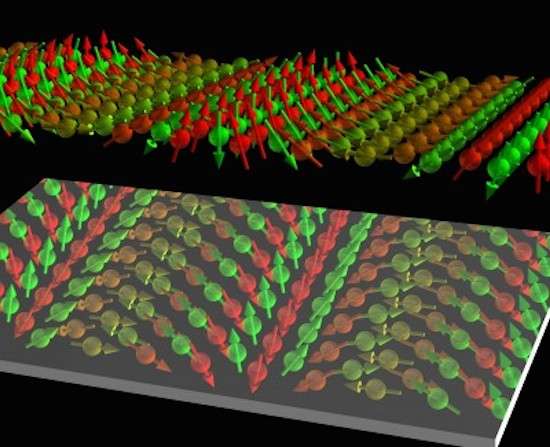Superconductivity trained to promote magnetization

Under certain conditions, superconductivity, which is basically incompatible with magnetism, can promote magnetization. Russian scientist Natalya Pugach from the Skobeltsyn Institute of Nuclear Physics at the Lomonosov Moscow State University discovered this still unexplained effect with her British colleagues, whose theory group was headed by Professor Matthias Eschrig. They suggest that techniques based on this effect can move us closer to future supercomputers—spintronic devices. Their study was published in Nature Physics.
The research team, which included Natalya Pugach from the Skobeltsyn Institute of Nuclear Physics, studied the interactions between superconductivity and magnetization in order to understand how to control electron spins (electron magnetic moments) and to create next-generation electronics.
In traditional microelectronics, information is coded via the electric charges. In spin electronics—or spintronics—information is coded via the electron spin, which can be directed along or against a particular axis.
"Superconducting spintronic devices will demand far less energy and emit less heat. It means that this technology will allow us to create much more economical and stable computing machines and supercomputers," Natalya Pugach explains.
The main obstacle to the development of these devices is that the spins of electrons and of other charged particles are very difficult to control. The results of this new research show that superconductors may be useful in the process of spin transportation, and ferromagnetics may be used to control spins.
Superconducting states are very sensitive to magnetic fields—strong magnetic fields destroy superconductivity, but superconductors expel magnetic fields completely. It is almost impossible to make ordinary superconductors and magnetic materials interact with each other due to their opposed magnetic ordering directions: In magnetic storage systems, the magnetic field arranges spins in one direction, but the Cooper pair (BCS pair) in ordinary superconductors have spins in the opposite direction.
"My colleagues experimented with devices called superconducting spin valves. They look like a 'sandwich' made of nanolayers of ferromagnetic material, superconductors and other metals. By changing the direction of magnetization, it is possible to control the current in the superconductor. The thickness of layers is crucial, because in the case of the 'thick' superconductor, it is impossible to see any interesting effects," Natalya Pugach explains.
During the experiments, scientists bombarded the experimental samples with muons (particles that resemble electrons, but are 200 times heavier) and analyzed their dissipation scattering. This method made it possible to understand how the magnetization proceeds in different layers of the sample.
The spin valve consisted of two ferromagnetic cobalt layers, one superconductive niobium layer with a thickness of approximately 150 atoms and a layer of gold. In the experiment, researchers discovered an unexpected effect: When magnetization directions in two ferromagnetic layers were not parallel, the interaction between these layers and the superconductive layer induced magnetization in the gold layer, jumping over the superconductor. When scientists changed the magnetization directions in two layers, making them parallel, this effect almost disappeared—field intensity decreased 20-fold.
"This effect was unexpected. We were very surprised to discover it. Previously, we tried to explain the results with a known magnetization distribution pattern, but in vain. We have some hypotheses, but we still do not have any complete explanation. Nevertheless, this effect allows us to use a new method of manipulations with spins," Natalya Pugach says.
It is quite possible that the finding will lead to conceptually new spintronic elements. According to Natalya Pugach, superconductive spintronics technologies may help to build supercomputers and powerful servers minimizing the energy consumption and heat emissions of current supercomputers.
"Computer technologies are based on semiconductors, which are good for personal computers. But when you use these semiconductors to build supercomputers, they produce heat and noise, and demand powerful cooling systems. Spintronics could solve all these problems," Natalya Pugach concludes.
More information: "Remotely induced magnetism in a normal metal using a superconducting spin-valve." Nature Physics (2015) DOI: 10.1038/nphys3486
Journal information: Nature Physics
Provided by Lomonosov Moscow State University




















